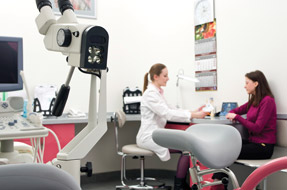ACP revises advice on women's health
New guidelines that change the recommendations for practices such as pelvic exams are leading to changes in the mindsets of physicians and patients.
For every action, there is an equal and opposite reaction, and Newton's third law becomes especially apparent in clinical practice when changes in guidelines elicit resistance. In terms of women's health, recent evidence-based ACP guidelines and advice attracted both pushback and praise from clinicians and patients.
In July 2014, ACP published a clinical practice guideline on annual pelvic examinations, recommending against the screening in asymptomatic, average-risk adult women. Evidence does not show that the benefits of screening pelvic exams lead to better clinical outcomes and outweigh harms, but clinicians have been routinely performing them for a long time, said lead author Amir Qaseem, MD, PhD, MHA, FACP.

“It has been going on for so many years, and now I think it's difficult for people to change that inertia, change their practice,” said Dr. Qaseem, director of clinical policy at ACP.
Pelvic exam
The goal of the pelvic exam recommendation is not to cut down on screening frequency, per se; rather, it's to balance the risks and benefits of screening a large population of asymptomatic patients, said co-author Thomas Denberg, MD, PhD, FACP.
“With the pelvic exam, the harms of screening outweigh the benefits, and the major risk is false positives,” said Dr. Denberg, a professor of medicine at Virginia Tech Carilion School of Medicine in Roanoke and executive vice president and chief strategy officer at Carilion Clinic. “False positives can generate a cascade of further testing, plus create a lot of anxiety in patients. And further testing can be costly and ... in extreme cases can lead to invasive procedures for no benefit at all and, possibly, in rare instances, substantial harm.”
The guideline states that screening pelvic exams are not a viable tool for diagnosing ovarian cancer, and the authors identified no studies that assessed their benefits for pelvic inflammatory disease, bacterial vaginosis, and other benign conditions. Anecdotally, however, gynecologist Lauren Streicher, MD, said she's identified many problems that have gone ignored because a woman's pelvic region hadn't been examined.
Dr. Streicher, associate clinical professor of obstetrics and gynecology at Northwestern University's Feinberg School of Medicine in Chicago, said that “[ACP] didn't look at the many, many other things that are picked up in an annual exam,” such as vulvar cancers, vaginal atrophy, pelvic organ prolapse, and urinary incontinence evidenced by wet, excoriated skin. Many women don't complain, but no complaint doesn't necessarily mean no problem, she said: “Every single gynecologist can tell you stories of things we have found in women who don't complain.”
The ACP guidelines are population-based and do not replace patient-clinician decision making, according to Dr. Qaseem. “The one important thing to keep in mind is that the physicians have to use their clinical judgment for individual patients,” he said. “Our guideline applies to the general population, and the majority of women will be exposed to harms, including fear, anxiety, and pain, and [worry about the exam could] possibly prevent women from getting necessary medical care. ... I also think we have to differentiate between evidence-based and expert-based opinions. Our guideline is evidence-based.”
Mixed reactions
Lisa Larkin, MD, FACP, an internist trained in women's health through the North American Menopause Society, agrees with the pelvic exam guideline. However, while the guideline cites discomfort and pain as reasons for not performing the exam, she said some of her patients request it. “I have a lot of patients who have been with me for 25 years. They—now, it's different for the younger generation—often feel like you are not doing a complete exam if you skip the pelvic. My patients ask,” said Dr. Larkin.
Despite patient resistance, she said she tries to follow the guideline change anyway. “It's just not always easy when you're sitting in front of the patient who's kind of thinking that you're not doing a complete exam if you're not doing it. And I think the gynecologists feel that, too, although this pelvic exam thing is debated hotly,” said Dr. Larkin, an associate professor in ob-gyn at the University of Cincinnati College of Medicine in Ohio who also serves as director for UC Health Women's Center.
“I'm sort of somewhere in the middle in that I think it's great that we actually finally have some evidence,” said ob-gyn Hope Ricciotti, MD. Although the exam may not improve health outcomes, she said that a piece that has been left out of the conversation is the importance of discussing reproductive issues and organs with women and empowering them to be in control of their sexual and reproductive health.
“I think those of us who do physical exams and the laying on of hands [think] the bonding it creates, especially when it comes to sensitive subjects, helps you to be able to ask the questions and/or communicate differently,” said Dr. Ricciotti, chair of the department of ob-gyn at Beth Israel Deaconess Medical Center and associate professor at Harvard Medical School in Boston.
“So when you think about screening for disease, reducing morbidity and mortality, the pelvic exam is at best limited,” she said. “But I think the issue is more that we don't want women's reproductive and sexual health and the organs involved to be stigmatized.”
Dr. Denberg countered, however, that clinicians can address these issues by holding a careful conversation and history-taking with the patient and said that the quality of that conversation is not contingent on an invasive examination.
As a medical educator, Dr. Ricciotti said she worries about possible deterioration in training. “If we stop doing these [screening pelvic exams] altogether, then the benefits that I mentioned are going to be lost because if you don't do a comfortable pelvic exam, you're not going to get very far,” she said.
Dr. Larkin also expressed worries about skill gaps in internal medicine trainees. “I do have some concerns about the fact that we'll just further erode physical exam skills on patients, and so then, we'll start missing things with patients with symptoms just because the new physicians can't do a great pelvic exam or haven't seen enough abnormalities on a vulvar exam to know what's OK and what's not OK,” she said.
Pap smears
ACP in April released new, less controversial best practice advice on cervical cancer screening. The College recommends beginning Pap tests at age 21 and performing them every 3 years until age 65. In addition, the recommendation offers the option of adding HPV testing every 5 years in high-risk women from ages 30 to 65. ACP recommends against cervical cancer screening in women who have had a hysterectomy with removal of the cervix.
In addition to minimizing false positives, avoiding preventable harm that can happen after false positives, and reducing costs, other benefits of evidence-based guidelines include a less complex screening strategy, said Dr. Denberg, co-author of the advice paper. He pointed out that for cervical cancer screening, ACP's guidelines and those from the American Congress of Obstetricians and Gynecologists are virtually identical.
“That's not always the case,” he said. “Sometimes professional society guidelines on the same topic diverge, and it causes a lot of confusion. I think 1 of the benefits here is that, at least with the case of cervical cancer screening, there's so much alignment that it really should help minimize confusion and uncertainty among practicing clinicians.”
Dr. Larkin said that the cervical cancer screening guideline has been easier to “sell” to patients than the pelvic exam guideline. “When I say sell: Get them to understand the rationale for decreased screening,” she said. “That conversation with them really seems to make sense.”
However, Dr. Streicher said she fears that the new Pap smear guidance may cause patients to come in for their annual exams less often. “The biggest concern I have with the Pap smear recommendation is that the interpretation on the part of women is that ‘If I don't need a Pap smear, I don't need an exam,’ and no one is looking at their cervix,” she said.
Although there's more clarity and consensus with this guideline, Dr. Ricciotti said she also worries that her patients will not come back each year. “Women under 25 are supposed to have an annual chlamydia screen if they're sexually active, and that's not going to happen if they don't come in,” she said.
Cancer screening strategies
ACP in May also released high-value care advice on screening for 5 types of cancer: cervical, ovarian, breast, prostate, and colorectal. The screening value framework is a parabola along a screening intensity continuum, with optimal screening intensity at a point where benefits most clearly outweigh harms and costs, according to lead author Timothy Wilt, MD, MPH, MACP. While physicians are familiar with the fact that low-value cancer screening occurs with underuse of effective tests, research now shows that at the furthest part of the parabola, the diminishing returns of higher-intensity screening decrease value as benefits level off and harms and costs rise exponentially, he said.
“There is increasing recognition that cancer screenings, like all health care interventions, are a tradeoff between potential benefits to a small number and harms and costs to a much larger number,” said Dr. Wilt, core investigator and staff physician at the Minneapolis VA Center for Chronic Disease Outcomes Research and professor at the University of Minnesota School of Medicine. “Implementing evidence-based health care through the ‘value lens' will resonate with many and lead to an optimal balance between benefits on the one hand and harms and costs on the other. This will provide the highest value of care to our patients,” he said.
Decreasing the use of low-value screening frees up resources for the complex patient population that does not have access to care, Dr. Qaseem said. “At a system level, you want to provide services that improve clinical outcomes and decrease the use of unnecessary services because then you can use up those dollars to provide necessary services to folks who have access to care, as well as those who don't have access to care,” he said.
For cervical cancer screening, the advice does not deviate much from ACP's earlier best practice advice, aside from an included recommendation against pelvic exams in women of any age. “Several years ago, we would've been screening women for cervical cancer beginning at age 18 and doing it annually,” Dr. Wilt said. “There is now widespread consensus that that does not improve outcomes and leads to higher costs and harms.”
For ovarian cancer screening, ACP does not identify any high-value screening strategies but recommends against CA 125 screening, transvaginal ultrasound, and screening pelvic examination in all women. “I think the ovarian one we all agree with,” Dr. Ricciotti said. “Nothing works for ovarian. ... It's not the biology of the tumor; it goes from 1 cell to metastatic. So right now, we're failing.”
Where there is disagreement, however, is with the breast cancer screening advice. ACP recommends discussing the benefits and harms of screening mammography in women ages 40 to 49 and doing biannual screening in patients who request it. For women ages 50 to 74, ACP says to encourage biannual mammography. The College does not recommend screening in healthy women under 40 or 75 and older, nor does it recommend screening those with a life expectancy of less than 10 years. Annual mammography, MRI, tomosynthesis, and regular systemic breast self-examination are not recommended.
There is a lack of consensus among professional groups regarding breast cancer screening, and for that reason, Dr. Larkin said the 40-to-49 age group sees a lot of physician variability. “I think the majority of physicians really do start screening at 40 pretty routinely. It's certainly what I do. Of all the guidelines that we've been talking about, that's the one where I have the most trouble saying that I would really not screen a 40-year-old,” she said.
Breast density is also a big issue for Dr. Larkin, whose own breast density concealed cancer on annual mammography until she felt the lump herself. “An average woman with no family history who's 40, who you would say is average risk, and maybe you don't really need to start screening until 50—well, if you do a mammogram at 40 on her and you find out that she's got extremely dense breasts, in my opinion, that does change her risk,” she said. Additionally, Dr. Larkin said she believes that in the next several years, there will be enough data to recommend tomosynthesis.
With breast self-exam, Drs. Larkin and Ricciotti said they encourage patients to have breast self-awareness rather than do systemic breast checks. “That's the role of breast self-exam, to understand normal anatomy and be comfortable with your body,” Dr. Ricciotti said. “But for cancer screening, not useful.” She added that she believes most ob-gyns would agree with ACP's breast cancer screening advice. “And I like it because of the conversation about pros and cons to the women in their 40s,” she said.
Finding the right balance of screening intensity can help clinicians provide the optimal value for their patients, Dr. Wilt said. “With regard to value of care, the ACP is leading with this. This is one concept, cancer screening, but you're seeing it in other areas. Particulars will change with time,” he said. “These will not be the same recommendations 20 years in the future, but hopefully the concept will begin to carry through.”





